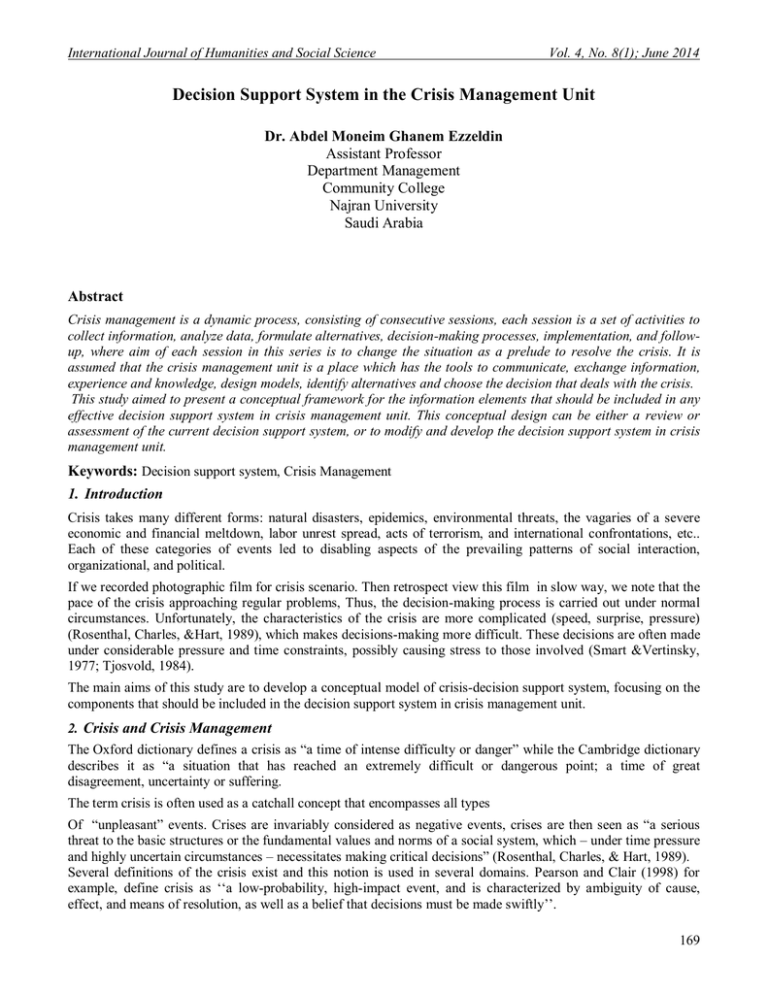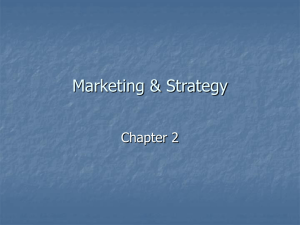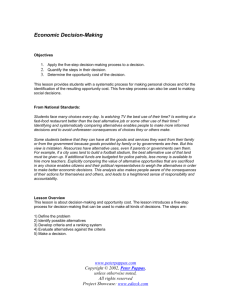Document 10465811
advertisement

International Journal of Humanities and Social Science Vol. 4, No. 8(1); June 2014 Decision Support System in the Crisis Management Unit Dr. Abdel Moneim Ghanem Ezzeldin Assistant Professor Department Management Community College Najran University Saudi Arabia Abstract Crisis management is a dynamic process, consisting of consecutive sessions, each session is a set of activities to collect information, analyze data, formulate alternatives, decision-making processes, implementation, and followup, where aim of each session in this series is to change the situation as a prelude to resolve the crisis. It is assumed that the crisis management unit is a place which has the tools to communicate, exchange information, experience and knowledge, design models, identify alternatives and choose the decision that deals with the crisis. This study aimed to present a conceptual framework for the information elements that should be included in any effective decision support system in crisis management unit. This conceptual design can be either a review or assessment of the current decision support system, or to modify and develop the decision support system in crisis management unit. Keywords: Decision support system, Crisis Management 1. Introduction Crisis takes many different forms: natural disasters, epidemics, environmental threats, the vagaries of a severe economic and financial meltdown, labor unrest spread, acts of terrorism, and international confrontations, etc.. Each of these categories of events led to disabling aspects of the prevailing patterns of social interaction, organizational, and political. If we recorded photographic film for crisis scenario. Then retrospect view this film in slow way, we note that the pace of the crisis approaching regular problems, Thus, the decision-making process is carried out under normal circumstances. Unfortunately, the characteristics of the crisis are more complicated (speed, surprise, pressure) (Rosenthal, Charles, &Hart, 1989), which makes decisions-making more difficult. These decisions are often made under considerable pressure and time constraints, possibly causing stress to those involved (Smart &Vertinsky, 1977; Tjosvold, 1984). The main aims of this study are to develop a conceptual model of crisis-decision support system, focusing on the components that should be included in the decision support system in crisis management unit. 2. Crisis and Crisis Management The Oxford dictionary defines a crisis as “a time of intense difficulty or danger” while the Cambridge dictionary describes it as “a situation that has reached an extremely difficult or dangerous point; a time of great disagreement, uncertainty or suffering. The term crisis is often used as a catchall concept that encompasses all types Of “unpleasant” events. Crises are invariably considered as negative events, crises are then seen as “a serious threat to the basic structures or the fundamental values and norms of a social system, which – under time pressure and highly uncertain circumstances – necessitates making critical decisions” (Rosenthal, Charles, & Hart, 1989). Several definitions of the crisis exist and this notion is used in several domains. Pearson and Clair (1998) for example, define crisis as ‘‘a low-probability, high-impact event, and is characterized by ambiguity of cause, effect, and means of resolution, as well as a belief that decisions must be made swiftly’’. 169 © Center for Promoting Ideas, USA www.ijhssnet.com Most definition highlights three important aspects of a crisis. First, a crisis is a major, unpredictable event. Second, a crisis has a low probability of occurring and includes an element of surprise. Finally, a crisis is requiring a quick response in order to minimize its impact (Pearson, Misra, Clair, &Mitroff, 1997). In this perspective, the term crisis applies to all situations that are unwanted, unexpected, unprecedented, and almost unmanageable, causing widespread disbelief and uncertainty (Rosenthal, Boin, & Comfort, 2001; Stern & Sundelius, 2002). A crisis is characterized by extreme threats to important values, intense time pressures, high stress, and the need for rapid, yet careful decision making (Biiiings, Milburn, & Schaaiman, 1980). Some characteristics reported in the literature defines a crisis as a situation due to a sudden, surprising and unexpected event (Bonn, & RundleThiele 2007). Gregory (2005) similarly reported that a literature review concludes crises are characterized as “high consequence, low probability, overlaid with risk and uncertainty, conducted under time-pressure,” and that causes severe consequences on human, environment, properties, large economic and social cost (Shrivastava, 1993). Unfortunately, these attributes of crisis make the crisis management more difficult, and require complex, urgent decision-making. While there is now a good degree of consensus about what is a crisis and what is an issue, there is much less consensus on how to define crisis management. No definition of issue management had achieved consensus (Heath, 1998). This lack of clarity suggests that while crises can properly be defined independent of crisis management, it is difficult to define issues independent of issue management. On the other hand “Crisis management” is -from to a certain extent- a contradiction in the terms. We do not manage the crisis; we try to anticipate the crisis, possibly to avoid it, to minimize its impact, to deal with the events and to restore the situation as soon as possible (Girard, et Al. 2006). Using the phenomenology of the crisis drawn from the experience feedbacks analysis, we can translate the concept of crisis management into more concrete actions. “Crisis management”, it is so, a dynamic process, consisting of consecutive sessions, each session is a set of activities to collect information, analyze data, formulate alternatives, decision-making processes and the implementation, and follow-up, where aim of each session in this series is to change the situation as a prelude to resolve the crisis. Crisis management involves prevention, mitigation, actual response, recovery (Heck, 1991), optimal use of time and resources (Regester, 1989), and fact finding, analysis, damage control and communication (Mitro & Pearson, 1993)Prevention, preparedness, response and recovery are commonly accepted as basic principles of crisis management. Green (1992) finds that a characteristic of crisis management is that ``one starts from a position inwhich control of events has been lost''. Regester (1989) further finds that ``crisis management involves establishing guidelines for action as ``time is at a premium and resource allocation is critical''. 3. Decision Support System (DSS) Several frameworks have been developed to describe the human decision making process. The most popular is Simon’s three-phase paradigm of intelligence, design, and choice (Simon, 1960).Traditionally, academics and practitioners have discussed building a decision support system (DSS) in terms of four major components: 1) the user interface, 2) the database, 3) the models and analytical tools, and 4) the DSS architecture and network (Sprague & Carlson, 1982). A component may be implemented with different technologies and each component has a different function or purpose unless the redundancy exists in the system. Different researchers, including Mallach (1994), Marakas (1999), and Turban & Aronson (1998) discussed the common characteristics of DSSs, which can be summarized as follows: • DSSs are used to support decision makers, not to replace them. • Provide support in semi-structured and structured decision contexts. • Support all phases of the decision-making process. • Support various managerial levels from top executives to individual contributors. • Usually, utilize models for analyzing decision- making situations and incorporate a database of some sort. 170 International Journal of Humanities and Social Science Vol. 4, No. 8(1); June 2014 4. Decision Support System for Crisis This study proposes Decision support system for Crisis, which contains five parts (see Figure 1). Figure 1: DSS for Crisis Linkage and Display Unit follow-upevents display information display the various resources political Design decision unitexperts military Intelligence unit Database unit DBMS Follow-up Communication s Prediction MBDS Investigate media DIALOG Develop alternatives unit Analysis Modeling Simulation 4.1 The Intelligence Unit This unit responsible for providing all the information required throughout the stages of decision-making. It should configure to be able to carry out its functions very quickly commensurate with the time constraints and the rapid change of the crisis. This unit includes all or some of the basic components: 1-Follow-up Component: the function of this component is to follow-up theater crisis, and present what is happening to the crisis management unit. 2-Communications Component: this component is to link the decision support system database, with data and information sources -from official entities-, which are expected their data and information related in any crisis, or which may be needed to manage any crisis The communication process must be systematically according to specific models and forms, in a way that helps save and update data and information in the decision support system database. 3-Investigate Component: This component represents a direct way or field survey to investigate some of the categories of data and information from primary sources. Some of the data and information is difficult to obtain, either difficulty provided systematically or because it has a special significance for Crisis Management. Such data and information require investigative component. 4-Prediction Component: in case of request information that is not available or in the case the information cannot be obtained regularly. This component prepares such information, by estimating this information, and measures the extent of compatibility using scientific methods. 171 © Center for Promoting Ideas, USA www.ijhssnet.com 4.2Develop Alternative Unit This unit is the basic unit of the decision support system, for its role in the preparation of the decision alternatives to deal with the crisis. The main function of the alternative unit is to design, analysis models for different types of crises, as well as the design of various models to deal with each type. This unit includes components: 1- Analysis Component: The role of this component is to study the different types of crises, and to identify the characteristics of each type, and to identify appropriate alternatives, also to defines the structure of the data required to design alternatives, The main function of the analysis component, is the analysis of the data - the data in the Decision Support System database, which is collected by or Intelligence Unit- to find information about the crisis factors, in order to prepare alternatives to deal with the crisis. 2-Modeling Component: this component responsible for building models that express the relations between all influencing factors relating to the crisis, as well as develop alternatives to deal with the crisis. 3-Simulation Component: The function of the component is to prepare the entire scenario of what could happen in reality, and also test the sensitivity of the alternatives to the changes expected. 4.3 Design Decision Uni The main goal of the decision unit is to determine the criteria for evaluating alternatives, logically evaluate the decision alternatives, and develop recommended actions that best meet the decision. Criteria Evaluation derived from national goals and objectives in general, which are used to evaluate the alternatives and choose the best alternative to the proposal of the decision. Design decision unit includes four main components: political component, a military component, media component, and experts component. The basic functions of the decision unit are: Evaluate alternatives, and develop a decision. Determination of the weights of non-quantifiable factors, and adopted as part of the evaluation criteria. Predict the implications of the decision. 4.4 Database Unit A database containing information and data about different aspects of the environment, the function of this unit is the gathering, classification and arrangement of data and information. In many cases, the data may be processed statistically to provide useful information, which helps to provide solutions that are not readily apparent, as well as assist in the evaluation and comparison between alternative solutions, and may recommend actions to be taken. The database unit includes: A database management system (DBMS), a model base management system (MBDS),and a dialogue management system (DIALOG). 4.5 Linkage and Display Unit This unit is an interactive interface to the database, as well as linking and coordination and integration between the units of the decision support system. The basic function of this unit is to concentrate information about the crisis in the forms and explanatory graph and comparative tables. We can use the display unit through three screens: the first screen to view and evaluate the crisis and follow-up events. The second screen to display the various resources available, which can be used in crisis management. The third screen is used to display information and comparisons between the alternatives, which are used in reaching the appropriate decision, The contents of the screen change according to changes in the crisis situation. 5. Conclusions The theoretical and conceptual framework used in this research project offered a basis for understanding the nature of the decision support system in a crisis situation, and enabled us to pay attention to the issues that are indispensable in the management of the crisis. We do not claim that all the components - which included in the model - not available in crisis management units, But this model can be a basis for the development of the actual system. Also, this design could be a way to review and evaluate the current system and its development. 172 International Journal of Humanities and Social Science Vol. 4, No. 8(1); June 2014 References Biiiings, R.S., Milburn, T.W., and Schaaiman,M.L. (1980). A Model of Crisis Perception: Theoretical and Empirical Analysis. Administrative Science Quarterly, 25, 300-316. Bonn I., Rundle-Thiele, S.(2007). Do or die—Strategic decision-making following a shock event. 28, 2, 615–620. Girard, et Al. (2006). Rapport de la mission d'évaluationetd'expertise de la veille sanitaire en France, rapport de veille sanitaire du Ministère de la santé. Green, P.S. (1992).Reputation Risk Management. Pitman, Financial Times, London, 67. Gregory, A. (2005). Communication dimensions of the UK foot and mouth disease crisis 2001. Journal of Public Affairs, 5, 312–328. http://www.sante.gouv.fr/htm/actu/rapport_veille_sanitaire/rapport.(6/2014). http://www.oxforddictionaries.com,(6/2014) http://dictionary.cambridge.org, (6/2014) Heath, R. L. (1998). Strategic Issues Management: Organizations and Public Policy Challenges. (3rd ed.). Sage Publications Asia-Pacific . Heath, R. (1998). Dealing with the complete crisis, the crisis management shell structure. Safety Science, 30 (1), 139–150. Heck, J.P. (1991). Comments on“TheZeebrugge ferry disaster”. In: Rosenthal, U. Pijnenburg, B. (Eds.).Crisis Management and Decision Making. Kluwer, Dordrecht, 75-79. Mallach, E., G. (1994). Understanding decision support systems and expert systems. Burr Ridge, Illinois: Irwin. Marakas, G., M. (1999).Decision support systems in the 21st century. Upper Saddle River, New Jersey: Prentice Hall. Mitro, I.I., Pearson, C.M. (1993). Crisis Management: A Diagnostic Guide for improving Your Organi- zation's Crisis-Preparedness. Jossey-Bass, San Francisco, CA. Pearson, C. M., & Clair, J. A. (1998).Reframing crisis management. Academy of Management Review, 23(1), 59–76. Pearson, C. M., Misra, S. K., Clair, J. A., &Mitroff, I. I. (1997).Managing the unthinkable. Organizational Dynamics, 26, 51–64. Rosenthal, U., Hart, P., & Charles, M. T. (1989).The world of crises and crisis management. In U. Rosenthal, M. T. Charles, & P. T. Hart (Eds.), Coping with crises. The management of disasters, riots and terrorism, Springfield, IL, 3–33. Rosenthal, U., Boin, R. A., & Comfort, L. K. (2001).The changing world of crisis management. In U. Rosenthal, R. A. Boin, & L. K. Comfort (Eds), Managing crises: Threats, dilemmas, opportunities, Springfield, IL, 5–27. Regester, M. (1989). Crisis Management: What To Do When The Unthinkable Happens. Business Books, London , 38. Shrivastava, P. (1993). Crisis theory/practice: Towards a sustainable future. Industrial and Environmental Crisis Quarterly, 7, 23–42. Sprague, R., S., &Carlson, E., D. (1982). Building Effective Decision Support Systems , Prentice - Hill , Englewood Cliffs New Jersey. Simon, H., A. (1960). The New Science of Management Decision.Harper & Brothers, New York. Smart, C., &Vertinsky, I. (1977). Designs for crisis decision units. Administrative Science Quarterly, 22(4), 640– 657. Thomas, T., Stern, E., &Sundelius, B. (2002). Crisis management Europe: An integrated regional research and training program. International Studies Perspectives, 3, 71–88. Tjosvold, D. (1984). Effects of crisis orientation on managers’ approach to controversy in decision making. Academy of Management Journal, 27(1), 130–138. Turban, E., & Aronson, J., E. (1998). Decision support systems and intelligent systems (5th ed.). Upper Saddle River, New Jersey: Prentice Hall. 173





